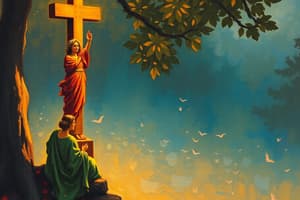Podcast
Questions and Answers
What is the first thing people want on the Path of Desire?
What is the first thing people want on the Path of Desire?
Pleasure
Which of the following are main ideas of Hinduism? (Select all that apply)
Which of the following are main ideas of Hinduism? (Select all that apply)
- Exclusive beliefs
- Soulness/oneness with the universe & God (correct)
- Many paths - one goal (correct)
- You reap what you sow - cause & effect (correct)
What is the second thing people want on the Path of Desire?
What is the second thing people want on the Path of Desire?
Wealth, fame, power
When do you start on the path to Renunciation?
When do you start on the path to Renunciation?
What is the first thing people want on the Path of Renunciation?
What is the first thing people want on the Path of Renunciation?
What is the second thing people want on the Path of Renunciation?
What is the second thing people want on the Path of Renunciation?
What does Atman refer to?
What does Atman refer to?
What must be eliminated to reach perfection? (Select all that apply)
What must be eliminated to reach perfection? (Select all that apply)
What does Yoga mean?
What does Yoga mean?
What is Jnana yoga?
What is Jnana yoga?
What is Bhakti yoga?
What is Bhakti yoga?
What does Karma yoga focus on?
What does Karma yoga focus on?
What are the two ways to approach work in Karma yoga? (Select all that apply)
What are the two ways to approach work in Karma yoga? (Select all that apply)
What does Japam refer to?
What does Japam refer to?
What is Ishta?
What is Ishta?
What does Raja yoga involve?
What does Raja yoga involve?
Match the layers of our minds with their definitions:
Match the layers of our minds with their definitions:
Match the stages of life with their descriptions:
Match the stages of life with their descriptions:
Match the stations of life with their roles:
Match the stations of life with their roles:
What are the rewards for being at each station of life? (Select all that apply)
What are the rewards for being at each station of life? (Select all that apply)
What does Jivas refer to?
What does Jivas refer to?
What is the first principle in learning to speak to God?
What is the first principle in learning to speak to God?
What does Brahman refer to?
What does Brahman refer to?
What does 'Sat, chit, ananda' mean?
What does 'Sat, chit, ananda' mean?
What is Nirguna Brahman?
What is Nirguna Brahman?
What is Saguna Brahman?
What is Saguna Brahman?
What are finite symbolic forms of Brahman? (Select all that apply)
What are finite symbolic forms of Brahman? (Select all that apply)
What does Om represent?
What does Om represent?
What does the Karmic cycle consist of?
What does the Karmic cycle consist of?
What does 'Samshara' mean?
What does 'Samshara' mean?
What does Moksha refer to?
What does Moksha refer to?
What are the aspects of our world according to Hinduism? (Select all that apply)
What are the aspects of our world according to Hinduism? (Select all that apply)
Flashcards are hidden until you start studying
Study Notes
Path of Desire
- First desire: Pleasure is pursued within moral boundaries.
- Second desire: Wealth, fame, power; these are limited, narcissistic, and impermanent.
Path of Renunciation
- Transition to Renunciation occurs when seeking deeper fulfillment beyond the Path of Desire.
- First focus: Community, duty, and purpose.
- Second focus: Being true to oneself, acquiring knowledge, and achieving happiness.
Key Concepts of Hinduism
- Core belief: Many paths lead to one goal, embracing inclusivity.
- Fundamental principles: Soulness and oneness with the universe, and the law of karma (cause and effect).
Atman and Brahman
- Atman: The hidden self or soul.
- Brahman: The absolute and infinite God, representing the Godhead; seen in Nirguna (without attributes) and Saguna (with attributes) forms.
Yoga and Paths to Enlightenment
- Yoga signifies a 'yoke' and represents various paths to God/enlightenment.
- Jnana yoga: Achieving God through knowledge via learning and reflection.
- Bhakti yoga: The path of love, recognizing God as separate and worshiping Him through different forms.
- Karma yoga: The way to God through work, approached reflectively or lovingly.
- Raja yoga: Involves psychophysical exercises aimed at understanding God and the eternal self.
Mind Layers
- Comprises physical body, conscious mind, individual subconscious, and eternal self (being).
Life Stages and Stations
- Stages of life: student, householder (focus on desires), and retirement (reflection and renunciation).
- Stations of life: Brahmins (intellectuals), Kshatriya (administrators), Vaishya (producers), Shudra (laborers).
- Rewards of each station include respect, power, wealth, and freedom.
Spiritual Communication
- First principle in communicating with God: use 'neti...neti' (not this...not this) to understand what not to say.
Creative Divine Forms
- Finite symbolic forms of Brahman include Brahma (creator), Vishnu (preserver), and Shiva (destroyer).
Concepts of Existence
- Om: Represents the sound of the universe; symbolizing unity and the essence of existence.
- Karmic cycle: Birth, life, death, and rebirth; life's journey as a bridge to various worlds.
- Maya: Not entirely "real"; reflects the illusory nature of the world.
- Lila: Describes the divine play of God.
- Moksha: Represents release from the cycle of samsara (wandering).
Essence of Existence
- "Sat, chit, ananda": Translates to being, consciousness, and bliss which signifies the ultimate experience of divinity.
Studying That Suits You
Use AI to generate personalized quizzes and flashcards to suit your learning preferences.




